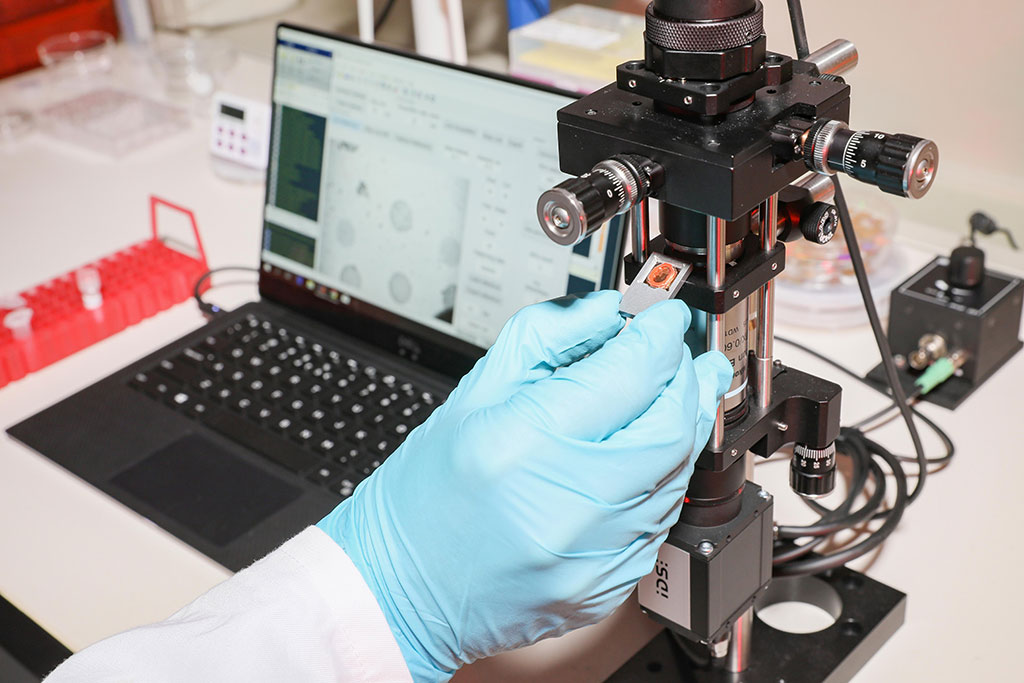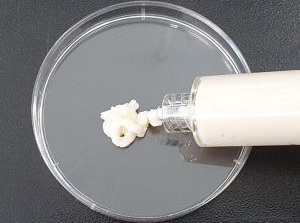Portable Nanoplasmonic Imager Detects Sepsis Faster 
|
By HospiMedica International staff writers Posted on 05 Feb 2020 |

Image: A nano-scale optical biosensor can rapidly detect sepsis (Photo courtesy of EPFL)
A highly portable device based on a nano-scale optical biosensor can rapidly detect inflammatory biomarkers in a patient's bloodstream.
Developed at Ecole Polytechnique Fédérale de Lausanne (EPFL; Switzerland), Hospital Universitari Vall dHebron (Barcelona, Spain), and Universitat Autònoma de Barcelona (UAB, Spain), the new device employs a gold-based metasurface that concentrates light around billions of nanoholes. Nanoparticles that capture the sepsis biomarkers procalcitonin (PCT) and C‐reactive protein (CRP) are distributed on the metasurface, and those that have captured biomarkers are trapped in the nanoholes. When an LED is applied, they partially obstruct the light passing through the perforated metasurface, allowing detection with a CMOS camera.
In field studies with a wide range of patient samples with sepsis, noninfectious systemic inflammatory response syndrome (SIRS), and healthy subjects, the device achieves an outstanding limit of detection of 21.3 pg mL−1 for PCT and 36 pg mL−1 for CRP. The results were validated against clinical diagnosis and currently used immunoassays, providing a performance level equivalent to the gold‐standard laboratory tests. Importantly, the plasmonic imager can enable identification of PCT levels typical of sepsis and SIRS patients in less than 15 minutes. The study was published on January 23, 2020, in Small.
“The device proved to be particularly suitable for on‐site operation due to its portability, inexpensive off‐the‐shelf optical components, and because it does not involve any moving parts or complex microfluidic elements prone to clogging,” concluded lead author Alexander Belushkin, PhD, of the EPFL Institute of BioEngineering, and colleagues. “Importantly, the sensor chips and bioassay reagents can be stored in the fridge stably over weeks and unlike previously reported optical detection schemes, do not require fluorescent tags that can be expensive, unstable, and difficult to produce.”
Sepsis is the primary cause of death in hospitals, and one of the ten leading causes of death worldwide, claiming a life every four seconds. It is associated with the body's inflammatory response to a bacterial infection and progresses extremely rapidly: every hour that goes by before it is properly diagnosed and treated increases the mortality rate by nearly 8%. Time is critical with sepsis, but the tests currently used in hospitals can take up to 72 hours to provide a diagnosis.
Related Links:
Ecole Polytechnique Fédérale de Lausanne
Hospital Universitari Vall dHebron
Universitat Autònoma de Barcelona
Developed at Ecole Polytechnique Fédérale de Lausanne (EPFL; Switzerland), Hospital Universitari Vall dHebron (Barcelona, Spain), and Universitat Autònoma de Barcelona (UAB, Spain), the new device employs a gold-based metasurface that concentrates light around billions of nanoholes. Nanoparticles that capture the sepsis biomarkers procalcitonin (PCT) and C‐reactive protein (CRP) are distributed on the metasurface, and those that have captured biomarkers are trapped in the nanoholes. When an LED is applied, they partially obstruct the light passing through the perforated metasurface, allowing detection with a CMOS camera.
In field studies with a wide range of patient samples with sepsis, noninfectious systemic inflammatory response syndrome (SIRS), and healthy subjects, the device achieves an outstanding limit of detection of 21.3 pg mL−1 for PCT and 36 pg mL−1 for CRP. The results were validated against clinical diagnosis and currently used immunoassays, providing a performance level equivalent to the gold‐standard laboratory tests. Importantly, the plasmonic imager can enable identification of PCT levels typical of sepsis and SIRS patients in less than 15 minutes. The study was published on January 23, 2020, in Small.
“The device proved to be particularly suitable for on‐site operation due to its portability, inexpensive off‐the‐shelf optical components, and because it does not involve any moving parts or complex microfluidic elements prone to clogging,” concluded lead author Alexander Belushkin, PhD, of the EPFL Institute of BioEngineering, and colleagues. “Importantly, the sensor chips and bioassay reagents can be stored in the fridge stably over weeks and unlike previously reported optical detection schemes, do not require fluorescent tags that can be expensive, unstable, and difficult to produce.”
Sepsis is the primary cause of death in hospitals, and one of the ten leading causes of death worldwide, claiming a life every four seconds. It is associated with the body's inflammatory response to a bacterial infection and progresses extremely rapidly: every hour that goes by before it is properly diagnosed and treated increases the mortality rate by nearly 8%. Time is critical with sepsis, but the tests currently used in hospitals can take up to 72 hours to provide a diagnosis.
Related Links:
Ecole Polytechnique Fédérale de Lausanne
Hospital Universitari Vall dHebron
Universitat Autònoma de Barcelona
Latest Critical Care News
- Early Detection and Targeted Blood Purification Could Prevent Kidney Failure in ICU Patients
- New Cancer Treatment Uses Sound-Responsive Particles to Soften Tumors
- Sprayable Powder-Type Hemostatic Agent Stops Bleeding in One Second
- Ultra-Stable Mucus-Inspired Hydrogel Boosts Gastrointestinal Wound Healing
- AI Model Helps Diagnose Often Undetected Heart Disease from Simple EKG
- E-Tattoos Harvest Energy and Monitor Health in Real Time
- Focused Ultrasound Tricks Tumors into Marking Themselves for Destruction
- World's Smallest Programmable Robot Opens Up New Possibilities in Medicine
- Remote Ventilate View Platform Enables Real-Time Monitoring of Patient-Ventilator Asynchrony
- Soft “Cyborg” Cardiac Patches Improve Stem Cell Heart Repair
- Soft Wearable System Offers Continuous Wireless Monitoring of Neonatal Health
- AI-Enhanced Wearables Could Transform Type 2 Diabetes and Prediabetes Care
- Breathable Electronic Skin Paves Way for Next-Generation Wearable Devices
- AI Transforming Colon Cancer Diagnosis
- Ventricular Assist Device Offers Long-Term Use in Children Waiting for Donor Heart
- Precision Approach Improves Immunotherapy Effectiveness for ICU Patients with Sepsis
Channels
Critical Care
view channel
Early Detection and Targeted Blood Purification Could Prevent Kidney Failure in ICU Patients
Acute kidney injury (AKI) is one of the most dangerous complications in intensive care units, affecting up to half of critically ill patients and sharply increasing mortality risk. A common but preventable... Read more
New Cancer Treatment Uses Sound-Responsive Particles to Soften Tumors
Cancer remains a leading cause of death in the U.S., and while treatments such as chemotherapy and ultrasound can be effective, they often damage healthy tissue. A major challenge is delivering enough... Read moreSurgical Techniques
view channel
Injectable Breast ‘Implant’ Offers Alternative to Traditional Surgeries
Breast cancer surgery can require the removal of part or all of the breast, leaving patients with difficult decisions about reconstruction. Current reconstructive options often rely on prosthetic implants... Read more
AI Detects Stomach Cancer Risk from Upper Endoscopic Images
In many parts of the world, doctors must make complex clinical decisions with limited access to specialist support, advanced diagnostics, or pathology services. This is especially challenging in gastrointestinal... Read morePatient Care
view channel
Revolutionary Automatic IV-Line Flushing Device to Enhance Infusion Care
More than 80% of in-hospital patients receive intravenous (IV) therapy. Every dose of IV medicine delivered in a small volume (<250 mL) infusion bag should be followed by subsequent flushing to ensure... Read more
VR Training Tool Combats Contamination of Portable Medical Equipment
Healthcare-associated infections (HAIs) impact one in every 31 patients, cause nearly 100,000 deaths each year, and cost USD 28.4 billion in direct medical expenses. Notably, up to 75% of these infections... Read more
Portable Biosensor Platform to Reduce Hospital-Acquired Infections
Approximately 4 million patients in the European Union acquire healthcare-associated infections (HAIs) or nosocomial infections each year, with around 37,000 deaths directly resulting from these infections,... Read moreFirst-Of-Its-Kind Portable Germicidal Light Technology Disinfects High-Touch Clinical Surfaces in Seconds
Reducing healthcare-acquired infections (HAIs) remains a pressing issue within global healthcare systems. In the United States alone, 1.7 million patients contract HAIs annually, leading to approximately... Read moreHealth IT
view channel
EMR-Based Tool Predicts Graft Failure After Kidney Transplant
Kidney transplantation offers patients with end-stage kidney disease longer survival and better quality of life than dialysis, yet graft failure remains a major challenge. Although a successful transplant... Read more
Printable Molecule-Selective Nanoparticles Enable Mass Production of Wearable Biosensors
The future of medicine is likely to focus on the personalization of healthcare—understanding exactly what an individual requires and delivering the appropriate combination of nutrients, metabolites, and... Read moreBusiness
view channel
Philips and Masimo Partner to Advance Patient Monitoring Measurement Technologies
Royal Philips (Amsterdam, Netherlands) and Masimo (Irvine, California, USA) have renewed their multi-year strategic collaboration, combining Philips’ expertise in patient monitoring with Masimo’s noninvasive... Read more
B. Braun Acquires Digital Microsurgery Company True Digital Surgery
The high-end microsurgery market in neurosurgery, spine, and ENT is undergoing a significant transformation. Traditional analog microscopes are giving way to digital exoscopes, which provide improved visualization,... Read more
CMEF 2025 to Promote Holistic and High-Quality Development of Medical and Health Industry
The 92nd China International Medical Equipment Fair (CMEF 2025) Autumn Exhibition is scheduled to be held from September 26 to 29 at the China Import and Export Fair Complex (Canton Fair Complex) in Guangzhou.... Read more
















